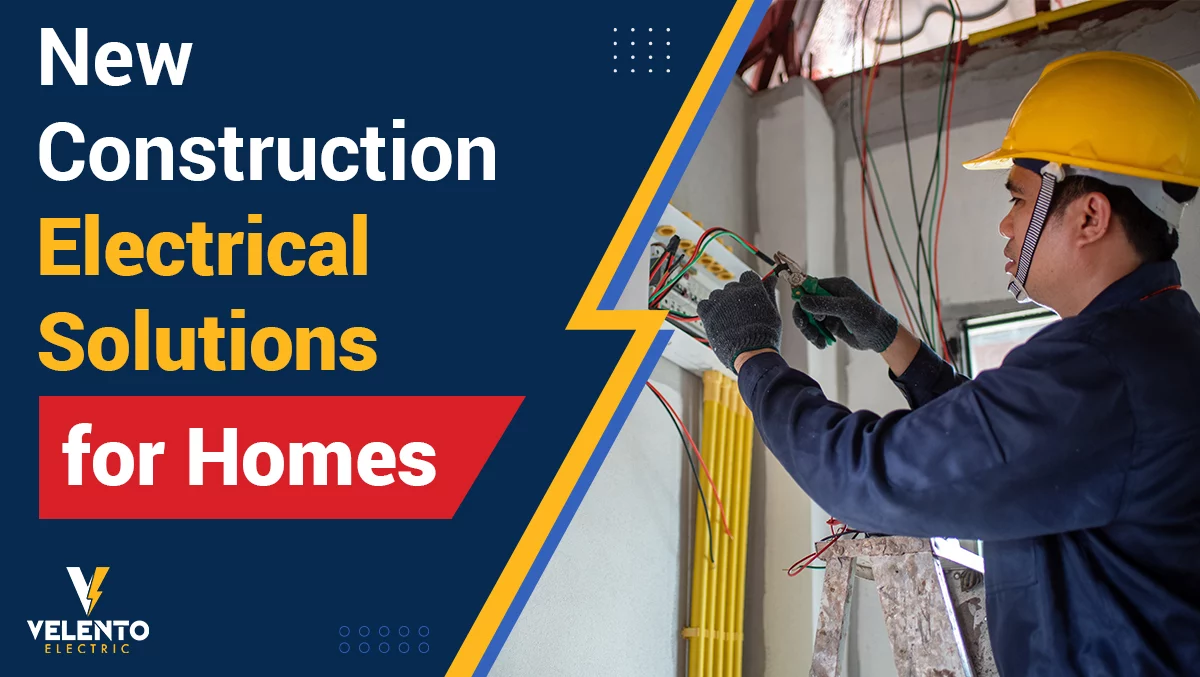Designing and implementing electrical solutions for new home construction requires careful planning to ensure safety, functionality, energy efficiency, and future scalability. Here’s a guide to creating a robust electrical system for a new home:
Planning the Electrical System
- Blueprint Review and Layout:
- Work closely with architects and homeowners to determine electrical requirements for each room.
- Mark locations for outlets, switches, lighting fixtures, and major appliances on the blueprint.
- Code Compliance:
- Ensure all installations meet local building codes and the National Electrical Code (NEC) requirements for safety.
- Load Calculation:
- Calculate the total electrical load to size the main panel and subpanels correctly.
- Account for future expansion (e.g., additional rooms, electric vehicles, or solar panels).
Essential Components and Solutions
- Main Electrical Panel:
- Install a panel with enough capacity for the home’s needs (e.g., 200-amp service is standard for modern homes).
- Include space for additional circuits for future upgrades.
- Circuit Design:
- Dedicated Circuits for high-power appliances like refrigerators, ovens, HVAC systems, and water heaters.
- Lighting Circuits: Separate circuits for general lighting to ensure uninterrupted illumination.
- General-Purpose Outlets: Install outlets on circuits designed for typical household use.
- Wiring Infrastructure:
- Use high-quality copper or aluminum wiring suitable for the load and environment.
- Consider conduit systems in areas where wires might need replacement or additional protection.
- Grounding System:
- Include proper grounding to prevent electrical hazards. Use grounding rods and ensure continuity across the system.
- Surge Protection:
- Install whole-house surge protectors at the main panel to guard against power surges and lightning strikes.
Modern Electrical Solutions
- Smart Home Integration:
- Pre-wire for smart home devices like thermostats, security systems, lighting controls, and smart outlets.
- Include Cat6 Ethernet cables for internet-connected devices.
- Energy Efficiency:
- Install LED lighting for reduced energy consumption.
- Use dimmer switches and motion sensors in areas like hallways and bathrooms.
- Renewable Energy Ready:
- Plan for solar panel installation by pre-wiring for photovoltaic systems.
- Include battery storage options for off-grid capabilities.
- Electric Vehicle (EV) Charging:
- Install a dedicated 240V circuit in the garage for an EV charging station.
- Backup Power Solutions:
- Install a transfer switch for generator connections.
- Consider whole-house battery backups or generators for seamless power during outages.
Convenience and Safety Features
- Outlet Placement:
- Install outlets every 6-12 feet in living spaces, as per code.
- Include floor outlets in larger rooms for flexible furniture layouts.
- GFCI and AFCI Protection:
- Install Ground Fault Circuit Interrupters (GFCIs) in wet areas (kitchens, bathrooms, outdoor spaces).
- Use Arc Fault Circuit Interrupters (AFCIs) to prevent electrical fires in bedrooms and living areas.
- Lighting Design:
- Plan for a mix of overhead lighting, task lighting, and accent lighting.
- Pre-wire for exterior lighting, including motion-activated and decorative fixtures.
- Ceiling Fans:
- Pre-wire for ceiling fans in bedrooms and living rooms for improved comfort and efficiency.
- Home Office and Entertainment:
- Provide ample outlets and USB ports in office spaces.
- Pre-wire for home theater systems and surround sound in entertainment areas.
Future-Proofing
- Expandable Circuits:
- Leave room in the main panel for future circuits.
- Use larger conduit where future cabling may be needed.
- Smart Grid Integration:
- Include infrastructure to connect to future smart grid systems for dynamic energy management.
- Zoning for HVAC and Lighting:
- Plan electrical zones that allow efficient energy use and easy upgrades.
- Pre-Wire for Emerging Technologies:
- Include wiring for future innovations such as advanced smart systems, solar integration, or enhanced security features.
Post-Construction Checks
- Inspection and Testing:
- Ensure all electrical work passes inspection.
- Test circuits, outlets, and devices to confirm proper function.
- User Orientation:
- Provide homeowners with a detailed map of circuits and advice on electrical maintenance.
- Warranty and Support:
- Offer a warranty for workmanship and guidance for addressing potential issues.
Room-Specific Electrical Solutions
- Kitchen:
- Install multiple circuits for high-demand appliances like microwaves, dishwashers, and refrigerators.
- Include under-cabinet lighting and outlets with USB ports for charging devices.
- Plan for a combination of task and ambient lighting, such as recessed lights and pendant fixtures.
- Bathroom:
- Use GFCI outlets near sinks and vanities for safety.
- Install ventilation fans with integrated lights or humidity sensors to prevent moisture buildup.
- Pre-wire for heated floors or towel racks if desired.
- Living Room:
- Plan for a mix of outlets and floor outlets for flexible furniture layouts.
- Pre-wire for a home theater system, including surround sound speakers and HDMI connections.
- Include dimmable lighting for ambiance control.
- Bedroom:
- Install ceiling fan wiring with separate switches for light and fan operation.
- Provide outlets on either side of the bed, equipped with USB ports.
- Pre-wire for TV mounts or entertainment setups if needed.
- Garage:
- Install dedicated circuits for tools or workshop equipment.
- Pre-wire for EV charging stations with a 240V outlet.
- Add motion-activated lighting and weatherproof outlets for outdoor tasks.
- Basement:
- Include ample outlets for future use, such as entertainment areas or home gyms.
- Pre-wire for a sump pump with a dedicated circuit.
- Plan for overhead lighting and accent lighting in finished areas.
- Outdoor Areas:
- Install weatherproof outlets for power tools, holiday lights, or patio equipment.
- Pre-wire for landscape lighting, including pathway lights and spotlights.
- Provide circuits for outdoor kitchens, pools, or hot tubs as needed.
Energy-Efficient Technologies
- Programmable Thermostats:
- Wire for smart thermostats that can optimize energy use and adapt to schedules.
- Smart Lighting Systems:
- Use hubs that allow control of lighting via smartphone apps or voice assistants.
- Pre-wire for centralized lighting control panels.
- Power Monitoring Systems:
- Include smart energy monitors that track electricity usage and identify inefficiencies.
Advanced Security and Safety Features
- Security Systems:
- Pre-wire for cameras, motion detectors, and alarm systems.
- Include hardwired smoke and carbon monoxide detectors, interconnected for whole-home alerts.
- Emergency Lighting:
- Install battery-backed lights in hallways and staircases for emergencies.
- Exterior Safety:
- Use motion-activated floodlights and strategically placed security cameras for enhanced outdoor safety.
Sustainable Power Options
- Solar Power Integration:
- Pre-wire for rooftop solar panel systems, including conduits and inverters.
- Plan for solar battery backups to store energy.
- Geothermal Systems:
- Integrate geothermal HVAC systems with dedicated electrical circuits.
- Wind Turbine Readiness:
- Pre-wire for micro wind turbines if applicable to the location.
Specialized Zones and Custom Features
- Home Offices:
- Install multiple outlets and hardwired Ethernet ports for high-speed internet.
- Plan for proper lighting, including desk lamps and overhead fixtures.
- Entertainment Areas:
- Pre-wire for streaming devices, gaming systems, and surround sound.
- Include HDMI and speaker wiring behind walls for a clean look.
- Workshops and Hobby Rooms:
- Provide dedicated circuits for high-powered tools.
- Include adequate lighting for detailed work, such as LED task lighting.
Professional Collaboration
- Coordination with Other Trades:
- Work with HVAC, plumbing, and smart home specialists to ensure seamless integration.
- Regular Inspections During Construction:
- Conduct inspections at key stages (rough-in, pre-drywall, final) to ensure compliance and quality.
Homeowner Education and Support
- Provide Documentation:
- Deliver a detailed electrical layout, including panel map and circuit identifiers.
- Offer Maintenance Tips:
- Educate homeowners on basic maintenance, such as resetting breakers or replacing GFCI outlets.
- Plan for Scalability:
- Include conduits and junction boxes for easy additions, such as extra circuits or new outlets.
Innovative Trends for Electrical Systems
- Wireless Charging:
- Install furniture or counters with built-in wireless charging pads.
- Voice-Controlled Systems:
- Pre-wire for smart speakers integrated into the home’s electrical and lighting systems.
- Microgrids:
- Plan for a home-based microgrid that combines solar panels, batteries, and smart controllers for energy independence.
Customized Electrical Features
- Hidden Charging Stations:
- Install pull-out drawers in kitchens, bedrooms, or home offices with built-in power outlets and USB ports for charging devices discreetly.
- Underfloor Heating Systems:
- Include electrical circuits for underfloor heating in bathrooms, kitchens, or living areas, providing comfort during colder months.
- Recessed and Cove Lighting:
- Plan for recessed lighting in ceilings for a sleek, modern look.
- Add cove lighting in living spaces or bedrooms for soft, ambient illumination.
- Built-in Nightlights:
- Install outlets with integrated LED nightlights in hallways, bathrooms, and children’s rooms for added safety at night.
- Touchless Switches:
- Use motion-activated or touchless switches in frequently used areas like bathrooms, kitchens, and entryways for convenience and hygiene.
Technology-Driven Solutions
- Centralized Control Systems:
- Integrate all home electrical systems into a centralized smart panel, allowing homeowners to control lighting, security, and HVAC from a single interface.
- Voice-Activated Features:
- Pre-wire for systems like Alexa, Google Assistant, or Apple HomeKit to control lighting, outlets, and appliances via voice commands.
- Lighting Scenes and Automation:
- Install programmable lighting to create custom scenes (e.g., “Relax Mode,” “Dinner Party”) that adjust brightness and color temperature automatically.
- Power Over Ethernet (PoE):
- Use PoE for low-power devices like security cameras, Wi-Fi access points, and intercoms, reducing the need for separate electrical circuits.
Luxury Home Additions
- Home Spa Solutions:
- Pre-wire for features like steam showers, saunas, or Jacuzzi tubs.
- Include circuits for towel warmers or heated mirrors to prevent fogging.
- Outdoor Entertainment Areas:
- Install waterproof outlets and pre-wire for outdoor sound systems, TVs, and decorative lighting.
- Smart Mirrors and Vanities:
- Wire for mirrors with integrated lighting, defoggers, and touch controls in bathrooms and dressing areas.
- Electric Blinds and Shades:
- Include wiring for motorized window treatments, controlled via remote or smart home systems.
Future-Proof Electrical Planning
- Expandable Conduit Systems:
- Use flexible conduit in walls to make it easier to add or upgrade wiring in the future.
- Dedicated Server Rooms:
- If the home is highly connected, allocate space for a dedicated server room with structured wiring for networking and smart systems.
- Home Battery Systems:
- Plan for large-scale home battery installations, like Tesla Powerwall or LG Chem, to store renewable energy and reduce reliance on the grid.
- Energy Management Systems:
- Install smart energy monitors that allow homeowners to track energy consumption in real-time and identify high-usage areas.
Enhancing Outdoor Spaces
- Garden and Landscape Lighting:
- Install low-voltage outdoor lighting for pathways, gardens, and driveways, adding both safety and aesthetic appeal.
- Pool and Hot Tub Wiring:
- Include circuits for underwater lighting, pool heaters, and filtration systems with GFCI protection.
- Outdoor Kitchens and Bars:
- Provide power for outdoor refrigerators, grills, and blenders, as well as outlets for charging devices.
- Outdoor Power Stations:
- Install weatherproof power stations in patios or play areas for powering tools or charging outdoor devices.
Energy-Saving and Sustainable Options
- Zonal Lighting Controls:
- Implement separate circuits for different zones, allowing homeowners to turn off lights in unused areas easily.
- Smart Thermostats with Zoning:
- Pre-wire for HVAC zoning, allowing different temperature settings in various parts of the house.
- Renewable Integration:
- Add wiring for wind turbines or geothermal energy systems if feasible based on the property’s location.
- Energy-Efficient Appliances:
- Design circuits to accommodate energy-efficient appliances, ensuring compatibility with advanced technology.
Safety Enhancements
- Enhanced Surge Protection:
- Install multiple layers of surge protection, including plug-level surge suppressors and panel-based systems.
- Smoke and Carbon Monoxide Detection:
- Hardwire interconnected detectors to ensure that all alarms sound simultaneously in case of an emergency.
- Emergency Power Circuits:
- Create dedicated circuits for essential areas, such as refrigerators, medical devices, or security systems, connected to backup generators or batteries.
Creative Aesthetic Features
- Accent Lighting:
- Add hidden LED strips in shelves, alcoves, or staircases for dramatic effects.
- Dynamic Color Lighting:
- Include RGB LED lighting systems for mood-setting in living rooms, bedrooms, or entertainment areas.
- Architectural Highlights:
- Use lighting to emphasize architectural features, such as beams, arches, or textured walls.
Professional Coordination
- Pre-Installation Consultations:
- Engage electricians, architects, and smart home specialists early in the design phase to avoid conflicts and ensure seamless integration.
- As-Built Documentation:
- Provide a detailed record of all wiring and systems for future reference or upgrades.
Advanced Home Automation Systems
- Smart Energy Management:
- Implement AI-driven energy management systems that analyze usage patterns and optimize energy consumption for appliances, lighting, and HVAC.
- Multi-Room Audio and Video Wiring:
- Pre-wire for centralized audio and video systems, allowing homeowners to stream music or movies seamlessly throughout the home.
- Occupancy Sensors:
- Install occupancy sensors in frequently used areas like kitchens, bathrooms, and hallways to automatically turn lights on and off, improving convenience and energy efficiency.
- Integrated Home Control Panels:
- Centralize the control of lighting, temperature, security, and entertainment systems with a single wall-mounted control panel or tablet integration.
Specialty Spaces and Applications
- Wine Cellars:
- Pre-wire for climate-controlled systems to maintain optimal temperature and humidity for wine storage.
- Include accent lighting to showcase wine collections.
- Laundry Room:
- Provide dedicated circuits for washer, dryer, and ironing stations.
- Install task lighting under cabinets and near workspaces for improved visibility.
- Mudrooms:
- Add outlets for charging stations for robotic vacuums or shoe sanitizers.
- Include heated flooring wiring for comfort during colder months.
- Game Rooms and VR Spaces:
- Plan for high-power outlets and HDMI wiring for gaming consoles, VR equipment, and home arcade systems.
- Use floor outlets or concealed wiring to prevent cable clutter.
Future-Focused Design
- Electrical Car Integration:
- Add multiple EV charging points for households with more than one electric vehicle.
- Include bi-directional chargers for vehicle-to-home (V2H) energy backup.
- Wireless Power Transfer:
- Explore emerging wireless charging solutions for small electronics and low-power devices.
- Smart Grid Compatibility:
- Enable integration with upcoming smart grid technologies for real-time energy demand management and dynamic pricing benefits.
- Advanced Home Batteries:
- Pre-wire for cutting-edge battery storage systems capable of supporting off-grid living or extended power outages.
Security Enhancements
- Perimeter Protection:
- Wire for perimeter security systems, including motion-activated cameras, tripwires, and floodlights.
- Panic Rooms:
- Install dedicated circuits for secure communication systems, independent power, and surveillance feeds for safe rooms.
- Video Doorbells and Intercoms:
- Pre-wire entry points for smart video doorbells and intercom systems that integrate with home automation.
Outdoor Innovations
- Custom Pool and Spa Features:
- Include automation for pool lighting, temperature control, and jet systems, integrated with smart home systems.
- Rooftop Entertainment:
- Pre-wire for rooftop entertainment setups, including outdoor speakers, weatherproof outlets, and mood lighting.
- Greenhouse Electrical Needs:
- Provide circuits for automated irrigation, heating, and grow lights in backyard greenhouses.
- Driveway Heating Systems:
- Install electrical heating under driveways and walkways to prevent ice and snow buildup.
Luxury and Convenience Features
- Smart Kitchen Solutions:
- Pre-wire for high-tech appliances, including smart refrigerators, ovens, and coffee makers.
- Include pop-up power stations on countertops for easy access.
- Hidden Outlet Solutions:
- Use retractable or flip-up outlets in kitchens, bathrooms, and workspaces for a clean aesthetic.
- Built-In Charging Drawers:
- Integrate hidden charging docks in furniture or cabinetry for discreet and organized device charging.
- Central Vacuum Systems:
- Wire for central vacuum systems with strategically placed access points throughout the home.
Sustainability-Focused Features
- Geothermal Heating and Cooling:
- Wire for geothermal HVAC systems that use renewable ground energy for efficient climate control.
- Rainwater Harvesting Systems:
- Include electrical connections for pumps and filtration systems in rainwater harvesting setups.
- Smart Window Tinting:
- Pre-wire for automated smart window tints that adjust opacity based on sunlight and temperature.
- Hydroponic Systems:
- Provide power for indoor hydroponic gardens, with options for automated lighting and nutrient delivery systems.
Enhanced Aesthetics and Functionality
- Lighting Zones:
- Create custom lighting zones with layered controls to highlight artwork, architectural features, or specific areas in open-concept spaces.
- Dynamic Exterior Lighting:
- Use color-changing LED systems for seasonal or event-specific exterior lighting themes.
- Art Display Wiring:
- Include outlets behind framed art or display niches for hidden lighting to enhance visual appeal.
- Interactive Walls:
- Pre-wire for interactive wall panels or digital displays for children’s playrooms or educational purposes.
Customized User Experiences
- Elderly and Accessibility Solutions:
- Design systems with low-placement switches, voice-activated controls, and illuminated pathways for senior residents or those with mobility challenges.
- Children’s Safety:
- Install tamper-resistant outlets and outlet covers for child safety.
- Include nightlights in children’s bedrooms and hallways.
- Home-Based Businesses:
- Plan for professional-grade office setups, including dedicated circuits for large monitors, printers, and high-speed internet.
- Enhanced Wellness Spaces:
- Pre-wire for yoga rooms or home gyms with built-in sound systems, lighting controls, and temperature regulation.
With these comprehensive and cutting-edge ideas, you can create a new home electrical system that combines functionality, luxury, and sustainability while being prepared for technological advancements and evolving homeowner needs.












